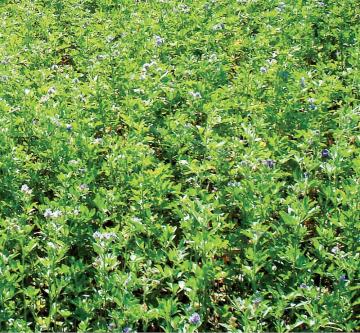
Lucerne (Medicago sativa)
Local name: Lucerne
Lucerne is a valuable leguminous forage and hay crop which is generally grown in areas, where water supply is inadequate for berseem. Its deeper root system makes it very well adaptable to dry areas with irrigation facility. It continues to supply nutritious fodder for 3-4 years. It is sown both as an annual and perennial crop. The crop is generally grown in irrigated areas to dry tracts and gives yield in well drained sandy loam soils.
The best time of sowing is between early October to end of November. First cutting is ready after 2-2.5 months of sowing. During rainy season its growth is affected by other monsoon grasses. After rains when soil is dried up, it is harvested or else there taken as a perennial crop it may yield up to 1000-1200 quintals per hectare, when taken as an annual (up to June), the yield is 700-900 quintals per hectare.
Nutritive value
Lucerne is a productive fodder which can support not only growth but also milk production up to 8 kg when fed ad lib. There are many varieties but types 8 and 9 developed at the fodder research station at Sirsa are recommended for adoption in Uttar Pradesh. It contains 18-22% crude protein and 25-35% crude fibre according to the maturity.
Deleterious factors
Lucerne contains saponins. Continuous feeding with early morning dew on, may lead to the risk of bloat or tympanitis in ruminants, mainly due to the foaming, hemicelluloses, higher quantity of soluble leaf cytoplasmic proteins, saponins and pectins. Ruminal tympanitis is overdistention of rumen and reticulum with the gases of fermentation either in the persistent form mixed with rumen contents or in the free gas form separated from the ingesta. Due to feeding of large quantity of lucerne, it results in primary ruminal tympany or frothing bloat.
